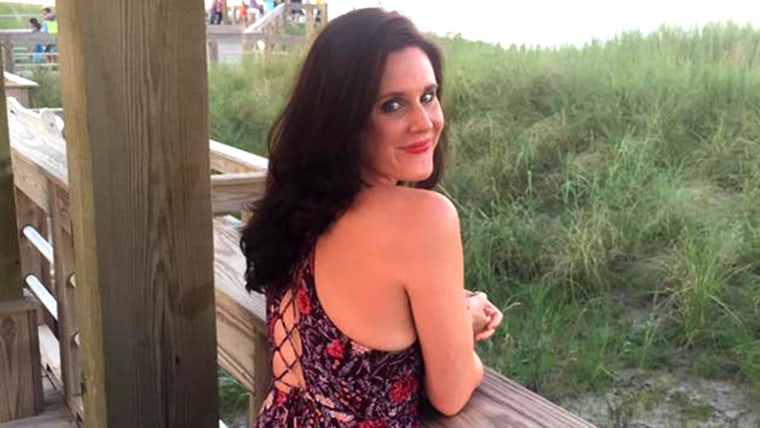I clearly remember the summer before I started sixth grade. I was 10 years old, and my mom let me shave my legs (under supervision.) I began wearing deodorant. My period started. And my once flat chest, umm, blossomed. In just a few short months, I needed a D-cup bra.
I was overwhelmed. So were my parents.

And I wasn’t really prepared for having a figure. I mean who was that curvy creature looking back at me in my pink, bedazzled mirror?
Over the years, having large breasts became integral to my image. I didn’t really know anything different so I thought any pain, swelling, bloating or tightness I felt was perfectly normal.
But a few years ago, my largest bra started to feel too small. If my breasts brushed up against something or someone, the pain was enough to make tear up. I couldn’t sleep on my stomach because my breasts were so firm.
I got worried that something was seriously wrong, so I visited my OB/GYN, stat.
I found out that like my mother (and her mother), I have fibrocystic breasts. Doctors used to call it fibrocystic breast disease. Now they refer to it as fibrocystic breast changes, or just fibrocystic breasts.
No matter what they call it, it’s still a big pain in the breasts. Literally.
Why? Because my breast tissue becomes lumpy. There are some lucky women who don’t have any symptoms, but others, like me, experience severe pain and tenderness. Maybe even swelling, among a laundry-list of other not-so-great reminders of our girls.
Related: 'I couldn't get out of bed': Signs of a thyroid disorder you shouldn't ignore
I’m not alone. In fact, more than half of all women have some form of fibrocystic breast changes during their lifetimes, but it generally happens to women in their 20s through their 50s, according to the Mayo Clinic.
“Fibrocystic breast changes are a very common, since normal breast tissue has a combination of fatty, fibrous, glandular, and cystic elements,” explains Dr. Catherine Goodstein, physician and partner at Carnegie Hill OB/GYN in New York City.
So what have I learned from having this condition? A few things:
I look forward to getting my period
I don’t have much worry about my period in terms of a pregnancy. I’m single and use an IUD. But how do I know when my period’s on its way? Spoiler: my boobs give me a signal.
Although doctors don’t know why some women have fibrocystic breasts, fluctuating reproductive hormones (especially estrogen) may be the culprit. These hormones control the four-weeks (roughly) that make up our reproductive cycles. Most women tend to have miserable symptoms right before their periods start. Then those symptoms become a lot more manageable during our periods.
“Many women with painful fibrocystic breast changes are relieved when they get their periods because they breast swelling diminishes and they feel more comfortable,” Goodstein says.
A big plus: fibrocystic breasts don’t raise your risk of breast cancer, according to the Mayo Clinic.
There are treatments
I was very nervous about what a diagnosis of fibrocystic breasts actually meant. Would my breast always be this uncomfortable? Would this happen every single month? Like any 20-something, I quickly phoned my mom and dished.
She calmly explained that not only does this condition run in our family, but that it was manageable and treatable.
Options can include over-the-counter pain relievers. Oral contraceptives can help, too. So did losing weight. I went from a nearly DD-cup to a C-cup bra, and while I still have dependable monthly symptoms, they have improved with weight management.
Exercise is important
Although movement would seem to make symptoms worse, some women report improved symptoms when they’re active, Goodstein says. That’s true for me. I call it the warm-up effect. If I get through the first five minutes of exercise, I start to feel better, especially when those feel-good brain chemicals called endorphins kick in.
One exercise essential: a supportive bra, especially for ladies who pack a larger size.
Cut back on caffeine, too
What we eat and drink can influence our hormones. And caffeine can be a problem for some women with fibrocystic breasts, according to Goodstein. Trust me though, it can be tough to give up your cup of Joe. Trust me though,But if you have breast sensitivity try a caffeine-free hot beverage in the morning. That’s because caffeine is a stimulant.
Related: Study finds more evidence coffee can be a life saver
And since your breasts are already susceptible, the added jolt of caffeine may cause them to be even more painful. A week before I expect my period to begin, I start gradually cutting back on my caffeine-rich coffee consumption.
How to talk to your doctor
You don’t need me to tell you this, but finding an OB/GYN you feel comfortable with is important to your health and well-being. Though it was awkward confessing to my doctor just how much pain I was experiencing up-top, getting the right diagnosis and information about my breasts makes life easier.
Every woman is different and what works for one woman may not be what’s best for another woman, says Goodstein. But a candid conversation and examination by your gyno can get you on the right side of fibrocystic breasts before having another ridiculously-uncomfortable month.